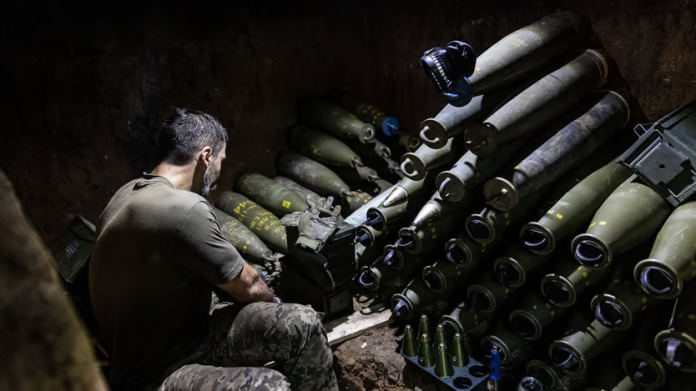For more than 600 days of military conflict in Ukraine, America has been its greatest ally, collecting weapons and money. Now, however, US aid is depleting, with Congress increasingly advocating the blocking of new aid, The Economist reports.
The impact is being felt on the front lines as the US tries to stretch its dwindling funds. Ukraine faces a severe winter of great uncertainty: its counter-offensive has failed to break through Russian positions; its enemy is mounting arms production; and its crucial ally is paralysed by political turmoil and distracted by Israel’s war in the Gaza Strip.
“In the spring the flow of military supplies was a broad river. In the summer it was a stream. Now it is a few drops of tears.”
US Defence Secretary Lloyd Austin visited Kyiv on November 20 to reassure Ukraine that the United States would support it “both now and into the future”. However, US funding is heavily dependent on Congress, where a Republican supporter has become speaker.
Twice since September, Congress has passed a “continuing resolution” to avoid a federal government shutdown; and twice it has excluded new aid to Ukraine.
President Joe Biden has requested a $106 billion supplemental budget, with $61 billion intended for Ukraine and the rest allocated to Israel and other national security priorities. Republicans are tying aid to Ukraine to tougher measures to restrict migration across America’s border with Mexico.
If no agreement can be reached before Christmas, the new aid could be delayed until after the November 2024 election. In addition, if Donald Trump is elected president, aid to Ukraine could be cut off.
However, Ukrainian leaders reject the idea that the US could cut off aid. Andriy Yermak, a top aide to Ukraine’s president, Volodymyr Zelensky, claimed to have found “strong bipartisan support” during his visit to Washington this month.
I don’t believe it will happen.
According to America’s calculations, it has provided about $75 billion in total aid to Ukraine since the start of the war, with European countries together providing more than $100 billion.
The US still provides most of the military aid: its contribution is about $44 billion. The Pentagon claims it has about $5 billion in “presidential drawdown authority” (PDA) left to supply Ukraine with weapons from its own arsenal, and just over $1 billion to replenish it.
Given the depleting military stockpiles in the West, as well as the crisis in the Middle East and the potential crisis over Taiwan, the White House may not want to contribute more than it is allowed to buy back.
PDA packages for Ukraine have dropped from an average of more than $1 billion a month (and a peak of more than $5 billion in January) to $350 million in October and just $250 million this month.
In addition, a separate pot known as the Ukraine Security Assistance Initiative (USAI), worth more than $18 billion, is nearly exhausted.
Josep Borrell, the European Union’s foreign-policy chief, urged European countries to substitute for the United States if necessary. Germany stated that it planned to double its support for Ukraine next year to 8.5 billion dollars, as well as to supply more air defence systems. The Netherlands, Finland and Lithuania have announced new military aid packages.
However, a constitutional court ruling in Germany looks set to thwart plans for more aid. The Freedom Party of Geert Wilders, who won the most seats in recent Dutch elections, opposes the arms shipments, raising questions about whether the Netherlands can still lead a coalition to supply F-16 aircraft to Ukraine.
Slovakia’s new government has already cut off military aid. Ukrainians are concerned that without American leadership, Europeans may decide to withdraw aid one by one.
Michael Kofman of the Carnegie Endowment for International Peace, an American think-tank, says Ukraine is already feeling the “shell-hunger.” He calculated that Ukraine was producing 220,000-240,000 larger calibre (152 and 155 mm) shells per month in the summer, but that the rate of fire was declining and would fall to 80,000-90,000 shells per month.
However, even these figures are more than America and European countries currently produce – about 28,000 and 25,000 per month respectively. The West plans to triple production, but it will take a year or more, and some of the output will be used to replenish Western stocks and supply others. Meanwhile, Russia is outpacing Western shell production and is being helped by a wave of supplies from North Korea, according to Kofman.
Ukraine is trying to develop its own defence industry, which was strong in Soviet times but has been severely neglected since then.
“No matter how much we grow local production, we would be hugely dependent on Western partnerships.”
If the US support declines, Ukraine would be unable to launch another major counter-offensive, Kofman said. However, according to Jack Watling of the Royal United Services Institute, a British think-tank, defeat is likely to be “slow and painful” rather than a sudden collapse. Yermak thinks otherwise:
We made our choice. We will be fighting for victory. But of course, this victory will be more quick and we will save more lives if the help will continue.
